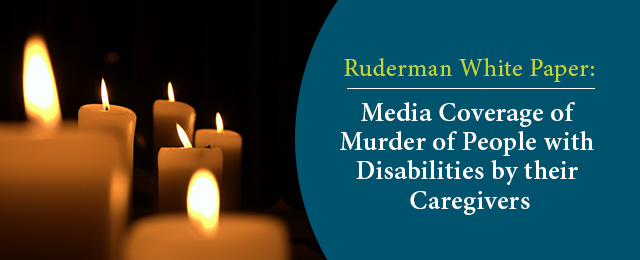
The Ruderman White Paper: Media Coverage of the Murder of People with Disabilities by their Caregivers
Each Week, at Least One Person with a Disability
is Murdered by Their Caregiver—the Media Covers it Poorly
[message_box title=”PREFACE” color=”blue”]
Approximately once a week, a person with a disability is murdered by a family member or caregiver. We have found that when these murders are covered, they are often called “mercy killings” which perpetuates the stigma and myth that the life of a person with a disability is not worth living and that it is a kind deed to end such a life. Such coverage simply must stop. It is dehumanizing and dangerously continues to stigmatize disability. We’ve found that the voices of the victims are nearly always erased to favor the perspectives of the perpetrators. This too must stop.
In this White Paper, we offer insight into a difficult phenomenon and offer resources and best practices to stop the stigmatization of disability.
[/message_box]
Transcript of Ruderman Podcast HERE
EXECUTIVE SUMMARY
For this White Paper, we looked at the media coverage of 260 cases of the killing of disabled people by the parents or other caregivers, ultimately narrowing our sample down to 219 cases in which the circumstances were clear. The cases date from January 2011 to December 2015. The cases range from clearly intentional acts of murder to death through neglect; the victims have a wide range of disabilities, and the legal outcomes vary from acquittal or no charge to lengthy prison sentences.
Our Goals
- Identify and assess the patterns in coverage. Analyze how those patterns might contribute to stigmatization of disability and disabled people and even intensify the risks of future crimes.
- Provide a comparative framework so that journalists covering such a story in their own community might have easily accessible references.
- Highlight the efforts of the self-advocate community to combat disability stigma, to demand victim-centered stories, and work for change.
National data repeatedly indicates that people with disabilities are at higher risk for violent crime than people without disabilities. The deaths of people with disabilities at the hands of caregivers, including parents, is a particularly tragic subset of this broader pattern. Moreover, when journalists cover the deaths of this vulnerable segment of the population, the focus is often directed at the murderer. Journalists, consciously or unconsciously, often write stories that build sympathy for the murderer and the circumstances that led them to their crime, while the person with a disability is erased from the story.
We have examined over 200 news reports about cases in North America between 2011-2015 that clearly describe the murder of a victim with a disability by a parent, child, spouse, or unrelated caregiver.
Findings
- At least 219 disabled people were killed by parents and caregivers between 2011-2015—an average of approximately a murder a week. This is a very conservative number due to under-reporting and the fact that a victim’s disability is not always made public. The real numbers are likely much higher.
- The killers routinely claim “hardship” as a justification for their acts. The media rarely questions such claims or asks for comment from disability rights organizations, and especially not from people with disabilities themselves.
- In the drive to explain a killing, the lives of the victims get erased resulting in killer-centered, rather than victim-centered reporting.
- Spreading the hardship narrative may lead to more violence, rather than changing policy around supports. In many cases, moreover, the narrative is fundamentally not true.
- Many killers receive little to no prison time. In such cases, perceptions of disability as suffering inform judicial decisions not to punish murder.
Best Practices
- Tell victim-centered stories. Don’t just report what the killer says about the victim, which will always be dehumanizing. Do the journalism to find out more about the victims’ lives, their desires, their agency.
- Talk to experts in disability. The disability rights community follows these cases closely and will provide expert commentary. Remember, most caregivers do not kill disabled people, so blaming a killing on disability-related hardship is never the full answer.
- Challenge the claims of defense attorneys and perpetrators. Investigate whether the claims of defense attorneys and perpetrators are accurate. When prosecutors treat such cases lightly, investigate whether they treat cases involving non-disabled victims the same way.
- Provide Context. These cases are rare (there are around 450 cases of parents killing children every year in the United States), but not unique. They need to be put in context so the consequences of dehumanizing disabled people can be made visible to the general public.
READ THE RUDERMAN WHITE PAPER
About the author Kristina Kopić, better known as Tina, is a former academic, a writer, a martial artist, and a fan of deconstructing all social constructs, especially those of gender, race, and disability in order to expose and challenge their injustices and create a more inclusive and fair world. She is the Advocacy Content Specialist at the Ruderman Family Foundation, lives with her wife, their two cats, and is currently dabbling in rugby.
Stay Included
To stay up to date on our most recent advocacy efforts, events and exciting developments, subscribe to our newsletter and blog!















